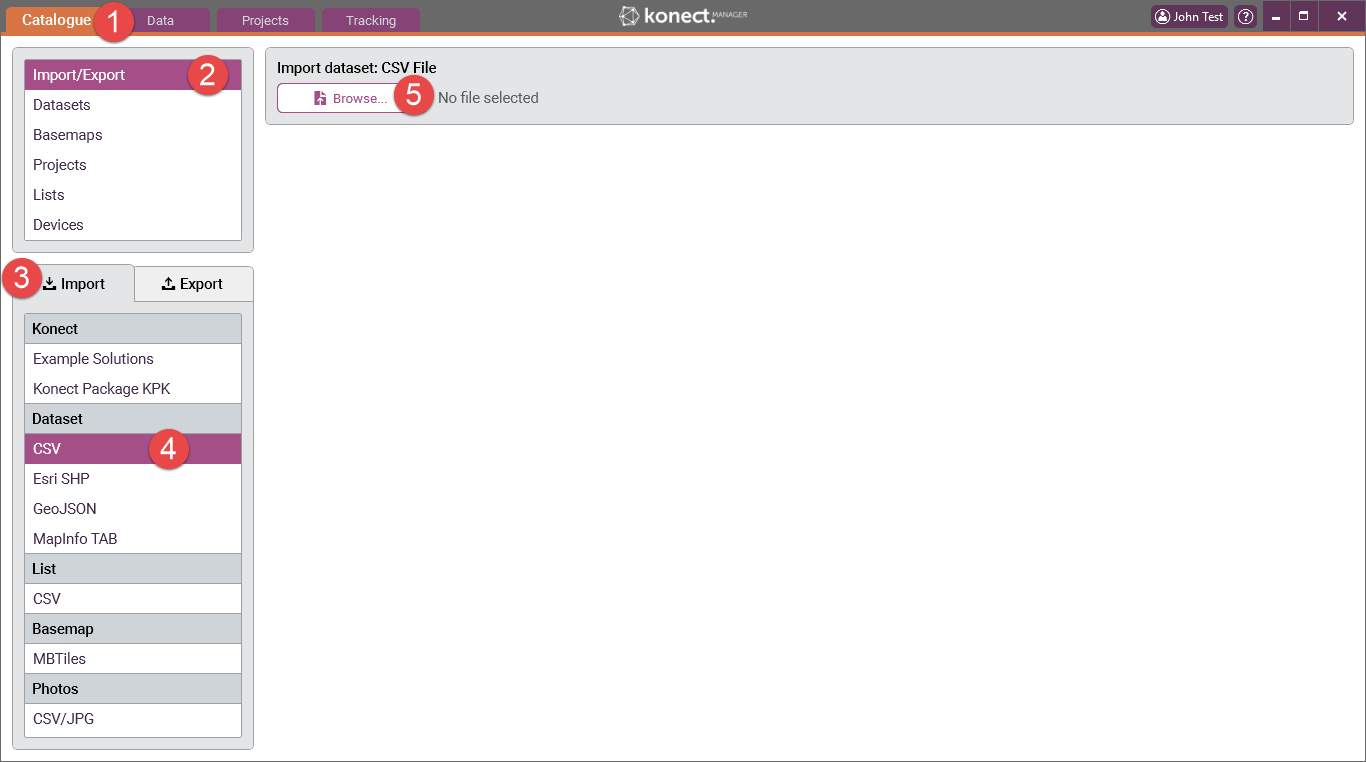...
Existing datasets may be available as CSV files as CSV is a particularly common data exchange format. CSV files can be brought into Konect and mapped as point features.
CSV files can be interpreted by Konect Manager as point feature GIS files if they have two columns that contain the longitude and latitude of point objects in the WGS 84 coordinate system.
STEP-BY-STEP
Imported data can be used to create a new dataset or be appended to an existing dataset.
...
If the two coordinate columns have the names ‘X’ and ‘Y’, then importing a CSV file is the same as importing a TAB or SHP file.
If the coordinate columns are not called ‘X’ and ‘Y’, then Konect Manager asks the user to select which columns contain the longitude and latitude.
As an example, import the file ‘Bins.CSV’ (available for download at Bins.zip) which stores the longitude and latitude in the columns ‘Long’ and ‘Lat’.
- Press the ‘Browse’ button and select the file ‘Bins.CSV’.
- The ‘Select geometry fields’ control appears.
- Select ‘Long’ for the longitude field and ‘Lat’ for the latitude field.
- Press the ‘Ok’ button
- Select ‘Create a new dataset’.
- Press the ‘Create new’ button.
- Press the ‘Yes’ button.
- Give the dataset the name ‘Bins’ and press ‘Ok’.
Go to the ‘Data’ tab and select the ‘Bins’ dataset to view the 6 bins that are along the streets George and Mary in the city of Brisbane, Australia.
The grid at the bottom of the ‘Data’ tab gives the aspatial bin information.
Note: the order of the records is not the same as in the file ‘Bins.CSV’.
Creating A New Dataset
To Use the following steps to create a new dataset by importing a TAB CSV file, do the following steps:
1 Go to the ‘Catalogue’ tab in Konect Manager.
...
3 Select the ‘Import’ tab.
4 Select ‘MapInfo TAB’ ‘CSV' in the ‘Dataset’ list.
5 Press the ‘Browse’ button. Select and 'Open' the required file. In this example we have used ‘FN Property.TAB’
‘Bins.csv' has been used.
6 Konect Manager reads the contents of the selected file and displays the number of records and the number of data fields in the file. It also draws a rectangle, called the bounding rectangle, that geographically encompasses all the map features in the file. The user can use this information to check that the correct data is being imported.
...
12 The records are appended and Konect Manager automatically goes to the ‘Datasets’ item in the ‘Catalogue’..
Importing CSV files
As mentioned above, Konect Manager can import a CSV file into a dataset if there are two columns in the file that contain the longitude and latitude of a point feature.
If the two coordinate columns have the names ‘X’ and ‘Y’, then importing a CSV file is the same as importing a TAB or SHP file.
If the coordinate columns are not called ‘X’ and ‘Y’, then Konect Manager asks the user to select which columns contain the longitude and latitude.
As an example, import the file ‘Bins.CSV’ (available for download at Bins.zip) which stores the longitude and latitude in the columns ‘Long’ and ‘Lat’.
...
Go to the ‘Data’ tab and select the ‘Bins’ dataset to view the 6 bins that are along the streets George and Mary in the city of Brisbane, Australia.
The grid at the bottom of the ‘Data’ tab gives the aspatial bin information.
Note: the order of the records is not the same as in the file ‘Bins.CSV’.




